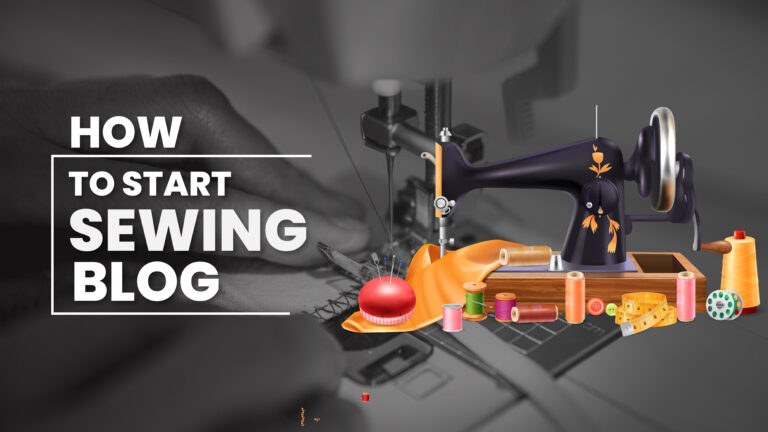Starting a sewing blog in 2025 presents an excellent opportunity to connect with a vibrant community of enthusiasts. As the craft of sewing continues to gain popularity, individuals seek platforms that provide inspiration, guidance, and a sense of belonging. A successful sewing blog captures the intricacies of sewing techniques, shares unique projects, and fosters engagement among readers. This comprehensive guide outlines the essential steps to create a thriving sewing blog, ensuring that you stitch together a creative community that celebrates the art of sewing.
How to Start a Sewing Blog (10 Easy Steps)
Step 1: Define Your Niche and Audience
To start a sewing blog, first define your niche and target audience. A focused niche helps attract readers who share similar interests. Popular sewing niches include:
- Fashion Sewing: Create clothing patterns and tutorials for those interested in wearable projects. This niche can include everything from dresses to activewear.
- Quilting: Share quilt designs, piecing techniques, and tips for both beginners and advanced quilters. This niche often appeals to those who enjoy both artistry and tradition.
- Home Decor: Offer sewing projects for home furnishings such as curtains, pillow covers, and table linens. This niche can attract crafters looking to enhance their living spaces.
- Sewing for Kids: Provide patterns and projects for children’s clothing, toys, and accessories. This niche often attracts parents and caregivers looking for creative ways to outfit their children.
- Sustainable Sewing: Focus on eco-friendly practices and materials, promoting upcycling and using organic fabrics. This niche appeals to environmentally conscious sewists.
Understanding your audience is crucial. Identify their demographics, interests, and pain points. Knowing your audience helps tailor content to their preferences. For instance, if your target audience includes beginners, focus on introductory tutorials and basic sewing techniques.
Step 2: Choose a Blogging Platform
Selecting the right blogging platform is essential for ease of use and functionality. Popular options for sewing blogs include:
- WordPress: Known for its flexibility and customization options. Ideal for those who want full control over their blog. WordPress also supports various plugins that can enhance functionality.
- Blogger: A straightforward platform suitable for beginners. Offers basic features and easy setup, making it accessible for those new to blogging.
- Squarespace: Known for its visually appealing templates. Great for those focusing on aesthetics and wanting a polished look without extensive design knowledge.
- Wix: Offers drag-and-drop functionality. Good for users seeking ease of use without technical skills, allowing for a quick setup and customization.
Choose a platform that aligns with your goals and technical abilities. Consider scalability, ease of use, and customization options. Your choice can affect your blog’s growth and functionality.
Step 3: Select a Domain Name
Choosing a unique and memorable domain name is crucial for your sewing blog. A good domain name reflects your niche and is easy to remember. Here are some tips for selecting a domain name:
- Keep It Short: Short names are easier to remember and type. Aim for 15 characters or fewer if possible.
- Make It Relevant: Include keywords related to sewing or your niche. This approach enhances discoverability and searchability.
- Avoid Special Characters: Stick to letters and numbers to prevent confusion. Hyphens can be misremembered or mistyped.
- Check Availability: Use domain registration sites to ensure your desired name is available. Popular registrars include GoDaddy, Namecheap, and Bluehost.
A strong domain name establishes your brand and aids in search engine optimization (SEO). It sets the tone for your blog and makes it easier for readers to find you.
Step 4: Design Your Blog
Designing your blog involves selecting a theme and layout that reflect your style. Here are some design tips:
- Choose a Clean Layout: A clutter-free layout enhances user experience. Prioritize simplicity to make navigation intuitive.
- Select Readable Fonts: Use clear, legible fonts for text. Avoid overly decorative fonts that can hinder readability.
- Incorporate High-Quality Images: Showcase your sewing projects with professional images. Good visuals attract attention and enhance engagement.
- Create Intuitive Navigation: Organize content logically for easy access. Use categories and tags to help readers find related content easily.
A well-designed blog attracts readers and keeps them engaged. The visual appeal plays a significant role in retaining visitors and encouraging them to return.
Step 5: Create Quality Content
Creating quality content is essential for engaging your audience. Focus on producing informative and engaging posts. Here are content ideas for your sewing blog:
- Tutorials: Step-by-step guides for sewing techniques or projects. These can range from beginner to advanced levels, catering to various skill sets.
- Pattern Reviews: Share insights on popular sewing patterns. Discuss ease of use, fit, and any modifications you made during sewing.
- Sewing Tips: Provide advice on tools, fabrics, and techniques. This content can help readers improve their skills and make informed decisions.
- Project Showcases: Display completed projects with detailed descriptions. Include information about materials, techniques used, and any challenges faced.
- Interviews: Feature other sewists or industry experts. These discussions can provide diverse perspectives and insights into the sewing community.
Aim for consistency in posting. Establish a schedule, whether weekly or bi-weekly, to keep your audience anticipating new content. Consistency builds loyalty among readers.
Step 6: Optimize for SEO
Optimizing your blog for search engines increases visibility and attracts organic traffic. Focus on the following SEO strategies:
- Keyword Research: Use tools like Google Keyword Planner to identify relevant keywords. Understanding popular search terms can help you tailor your content accordingly.
- On-Page SEO: Incorporate keywords naturally into titles, headings, and content. Avoid keyword stuffing; focus on natural integration.
- Meta Descriptions: Write compelling meta descriptions for each post to improve click-through rates. A well-crafted description summarizes the post and encourages clicks.
- Image Alt Text: Use descriptive alt text for images to improve search engine ranking. Alt text helps visually impaired users and boosts SEO.
Implementing effective SEO practices enhances your blog’s discoverability. SEO is a long-term strategy that requires continuous effort and adaptation.
Step 7: Promote Your Blog
Promotion is crucial for reaching a broader audience. Utilize various strategies to promote your sewing blog:
- Social Media: Share your posts on platforms like Instagram, Facebook, and Pinterest. Visual platforms work well for sewing content, allowing you to showcase your work effectively.
- Email Marketing: Build an email list to send newsletters and updates about new posts. Regular communication keeps your audience engaged and informed.
- Guest Posting: Collaborate with other bloggers by writing guest posts for their sites. This strategy exposes your blog to new audiences and builds credibility.
- Engage with Communities: Participate in online sewing communities and forums to share your expertise. Building relationships within these spaces fosters connections.
Effective promotion increases your blog’s visibility and fosters community engagement. Consider cross-promoting with fellow bloggers to reach new audiences.
Step 8: Build a Community
Building a community around your sewing blog enhances reader engagement and loyalty. Here are ways to cultivate a creative community:
- Encourage Comments: Prompt readers to share their thoughts and experiences in the comments section. This interaction fosters a sense of belonging.
- Host Challenges: Organize sewing challenges or contests to encourage participation. Challenges motivate readers to create and share their projects.
- Create a Facebook Group: Establish a dedicated group for discussions, project sharing, and support. A group fosters collaboration and interaction among members.
- Respond to Feedback: Engage with readers by responding to comments and emails. This engagement shows readers that their input is valued.
A supportive community fosters connections and encourages collaboration. The stronger the community, the more likely readers will return and participate.
Step 9: Monetize Your Blog
Monetizing your sewing blog can generate income while sharing your passion. Consider the following methods for monetization:
- Affiliate Marketing: Promote sewing products and earn a commission on sales through affiliate links. Partner with companies that align with your values and audience.
- Sponsored Posts: Collaborate with brands for sponsored content or product reviews. Sponsored posts can be lucrative if approached ethically.
- Sell Products: Offer your sewing patterns, kits, or handmade items for sale. This method creates a direct revenue stream while providing value to your audience.
- Online Courses: Create and sell courses on sewing techniques or specific projects. Courses allow you to share in-depth knowledge while generating income.
Diversifying income streams increases revenue potential while providing value to your audience. Consider what resonates best with your community and align your monetization strategy accordingly.
Step 10: Measure and Adapt
Regularly measure your blog’s performance to identify areas for improvement. Use analytics tools like Google Analytics to track:
- Traffic Sources: Understand where your readers come from. Knowing which channels drive traffic helps refine your promotional strategies.
- Popular Posts: Identify which content resonates most with your audience. Focus on creating more of what your audience enjoys.
- Engagement Metrics: Measure comments, shares, and other interactions. High engagement rates indicate content relevance and reader interest.
Analyzing this data allows you to adapt your content strategy to better serve your audience and improve engagement. Continuous improvement is key to long-term success.
Conclusion
Starting a sewing blog in 2025 involves defining your niche, creating quality content, promoting your blog, and building a community. By following these steps, you can stitch together a creative space for sewing enthusiasts. Focusing on quality, engagement, and monetization enhances your blog’s success.
As the sewing community continues to grow, your blog can become a valuable resource. Establishing connections and providing valuable insights fosters an environment where creativity flourishes.
Frequently Asked Questions (FAQs)
What topics should I cover in my sewing blog?
Cover topics such as tutorials, pattern reviews, sewing tips, project showcases, and industry news. Diversifying your content keeps your audience engaged.
How often should I post?
Aim for consistency. Whether it’s weekly or bi-weekly, a regular posting schedule helps retain audience interest.
Can I monetize my sewing blog?
Yes! Consider affiliate marketing, sponsored posts, selling products, or offering online courses to generate income.
How can I grow my sewing community?
Encourage comments, host challenges, and create social media groups. Engaging with your audience fosters a sense of community.
What blogging platform should I choose?
Consider your technical skills and desired features. WordPress is popular for its flexibility, while platforms like Squarespace offer ease of use.


No Comments
LMC Middle School https://lmc896.org in Lower Manhattan provides a rigorous, student-centered education in a caring and inclusive atmosphere. Emphasis on critical thinking, collaboration, and community engagement.
Your comment is awaiting moderation.